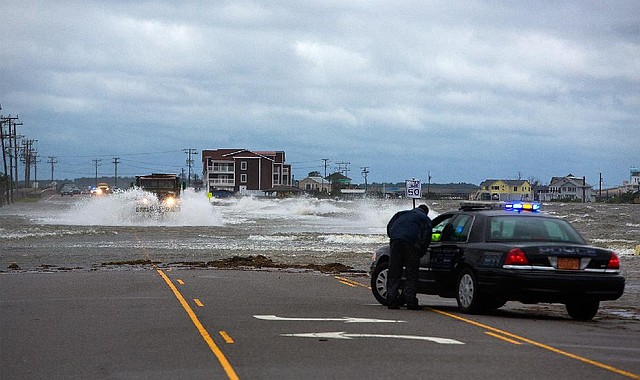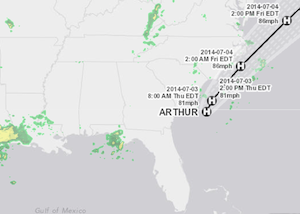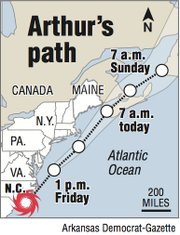Arthur dents N.C., zaps power
Weaker, hurricane climbs East Coast, pours on its beaches
Nags Head police block the traffic leading to Manteo, N.C. as emergency high clearance vehicle passes through the roadway and wind from the Hurricane Arthur pushes the sound water in south of Nags Head, N.C., Friday, July 4, 2014. Arthur struck North Carolina as a Category 2 storm with winds of 100 mph late Thursday, taking about five hours to move across the far eastern part of the state. (AP Photo/The Virginian-Pilot, Hyunsoo Leo Kim)
Saturday, July 5, 2014
KILL DEVIL HILLS, N.C. -- Hurricane Arthur left tens of thousands of people without power Friday in a swipe at North Carolina's Outer Banks, then caused lousy Fourth of July beach weather in the Northeast as it veered out to sea.
The weather in the Outer Banks -- narrow barrier islands that draw hundreds of thousands of tourists every summer -- had already cleared by Friday afternoon as Arthur scooted north and its outer bands scraped the Delaware and New Jersey shores.
Forecasters predicted the storm would weaken before its center moves over western Nova Scotia in Canada early today.
While state and local officials worked to restore access to Hatteras Island and to help those who had suffered storm and flooding damage, the effects of the hurricane were mostly confined to that part of the state. Farther south, the beaches were once again packed with people soaking up the sun Friday afternoon.
"The North Carolina beaches are open for business, and they're open for tourists," Gov. Pat McCrory said. "The umbrellas are going up as we speak right now."
Arthur struck North Carolina as a Category 2 storm with winds of 100 mph late Thursday, taking about five hours to move across the far eastern part of the state.
At the height of the storm, more than 40,000 people lost power, and the rush of water from the ocean on one side and the sound on the other side buckled part of North Carolina 12 in a spot on Hatteras Island that was breached in Hurricane Irene in 2011.
Dozens of workers were heading to fix the highway Friday, and the state Department of Transportation said it was confident the road would reopen today as long as an underwater sonar test of a key bridge showed no problems.
No injuries or deaths were reported. After praising emergency officials and saying the state dodged a bullet, McCrory said he was heading to the beach himself for an Independence Day parade in Southport.
Still, the first hurricane known to strike the U.S. on July 4 caused some frayed nerves in North Carolina. A mandatory evacuation was issued for the southern Outer Banks, but many residents stayed, accustomed to hurricanes that strike the area on average about every four or five years.
Jesse and Carol Wray rode out the storm in their home in Salvo on North Carolina 12. They said the island was under several feet of water at the height of the storm. The 6-foot-tall lamppost at the end of their driveway was under water except for its top, and that was after the sound a quarter-mile away receded several feet.
"There's a lot of damage to a lot of houses around here," Wray said. "Everything flooded out. All the businesses are flooded, and there was a lot of wind damage."
The bulk of the flooding and other damage on Hatteras Island appeared to have happened in the island's midsection in the villages of Rodanthe and Salvo. Farther south in Buxton, Angela Tawes is eager for the road to reopen, the ferries to resume and tourists to return with their money.
"We're all just holding our breath and hoping right now," said Tawes, whose family owns a grocery store, Conner's Supermarket.
Arthur is the first named storm of the Atlantic hurricane season. It is the earliest in the season that a hurricane has made landfall in North Carolina.
By Friday afternoon, the hurricane had weakened to a Category 1 storm with 80 mph winds. Its center was about 170 miles south-southwest of Chatham, Mass, at latitude 39.4 north and longitude 71.1 west.
While the Northeast wasn't expected to take a direct hit, the rain from Arthur's outer bands was disrupting the holiday. Fireworks displays in New Jersey and Maine were postponed until later in the weekend.
Tropical storm warnings were in effect for coastal areas as far north as Cape Cod, Mass. Tropical storm watches and warnings were in effect for Nova Scotia and New Brunswick in southeastern Canada.
McCrory said people in states to the northeast should heed to warnings about Arthur, even if North Carolina came through better than expected.
"I encourage them to take this very seriously, as we did, and hope for the best results," he said. "We've always felt that it was better to overreact than underreact, gladly this storm was more underwhelming than anticipated, which was very good news."
Information for this article was contributed by Martha Waggoner, Skip Foreman and Philip Marcelo of The Associated Press.
A Section on 07/05/2014


